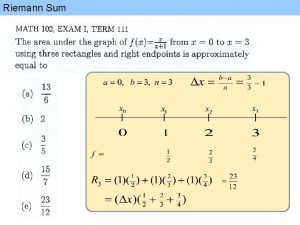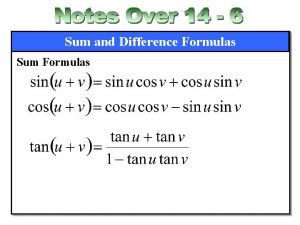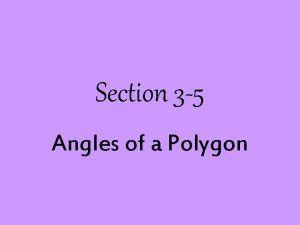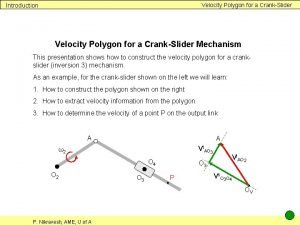Polygon Learning intentions What is a polygon Sum
















- Slides: 16

Polygon Learning intentions: What is a polygon? Sum of interior angles in polygons.

How can I find angle measures in polygons without using a protractor?

Polygon comes from Greek. Poly- means "many" gon means "angle". Many angles

What is a polygon? A polygon is a Plane shape with straight sides. Polygons are 2 -dimensional shapes. They are made of straight lines, and the shape is "closed" (all the lines connect up). Resource: http: //www. mathsisfun. com/geometry/polygons. htm l

Polygons

Nonexamples

http: //www. mathsisfun. com/geometry/polygons. htm l Types of Polygons Regular or Irregular If all angles are equal and all sides are equal, then it is regular, otherwise it is irregular Concave or Convex A convex polygon has no angles pointing inwards. More precisely, no internal angle can be more than 180°. If any internal angle is greater than 180° then the polygon is concave. (Think: concave has a "cave" in it) Convex Concave

Polygons Can be concave or convex. Concave Non-convex polygons have some diagonals that do not lie within the figure. Some interior angles are reflex (greater than 180°). Convex The diagonals of the convex polygon all lie within the figure.

Polygons are named by number of sides Number of Sides 3 4 5 6 7 8 9 10 12 n Polygon Triangle Quadrilateral Pentagon Hexagon Heptagon Octagon Nonagon Decagon Dodecagon n-gon

Sums of Interior Angles

Draw a: � Quadrilateral � Pentagon � Hexagon � Heptagon � Octogon Then draw diagonals to create triangles. A diagonal is a segment connecting two nonadjacent vertices (don’t let segments cross) Add up the angles in all of the triangles in the figure to determine the sum of the angles in the polygon. Complete this table Polygon # of sides # of triangles Sum of interior angles

Sums of Interior Angles Triangle Hexagon = 4 triangles Quadrilateral = 2 triangles Heptagon = 5 triangles Pentagon = 3 triangles Octagon = 6 triangles

Polygon # of sides # of triangles Sum of interior angles Triangle 3 1 180° Quadrilateral 4 2 2 x 180 = 360° Pentagon 5 3 3 x 180 = 540° Hexagon 6 4 4 x 180 = 720° Heptagon 7 5 5 x 180 = 900° Octagon 8 6 n-gon n n - 2 6 x 180 = 1080° (n – 2) x 180°

Polygon # of sides # of triangles Sum of interior angles Triangle 3 1 180° Quadrilateral 4 2 2 x 180 = 360° Pentagon 5 3 3 x 180 = 540° Hexagon 6 4 4 x 180 = 720° Heptagon 7 5 5 x 180 = 900° Octagon 8 6 n-gon n n - 2 6 x 180 = 1080° (n – 2) x 180°

The angle sum of a polygon with n sides is given by: angle sum = (n − 2) × 180° or 180(n − 2)° Find the angle sum of a polygon with 18 sides. Solution Angle sum = (18 − 2) × 180° = 16 × 180° = 2880° Find the angle sum of a polygon with sides. Solution Angle sum = (4 − 2) × 180° = 2 × 180° = 360°.

End
 Jabberwocky alliteration
Jabberwocky alliteration Learning intention examples
Learning intention examples Learning intentions examples
Learning intentions examples Learning intentions and success criteria examples
Learning intentions and success criteria examples Persuasive writing images
Persuasive writing images 640 739 in expanded form
640 739 in expanded form Poetry learning intentions
Poetry learning intentions Fractions learning intentions
Fractions learning intentions Half-turn symmetry
Half-turn symmetry Verb viper
Verb viper Poetry learning intentions
Poetry learning intentions Learning intentions and success criteria for mathematics
Learning intentions and success criteria for mathematics Poetry learning intentions
Poetry learning intentions Poem on peacock
Poem on peacock Creative writing learning intentions
Creative writing learning intentions Acrostic poem for smart
Acrostic poem for smart Drama learning intentions
Drama learning intentions































